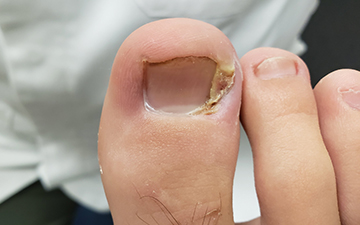
How to treat an ingrown toenail
Often ignored, an ingrown toenail can be quite painful and serious
Sometimes, it’s the smallest things that hurt the most. Anyone who has ever had a hang nail or a paper cut knows what I’m talking about. This is also the case with pains in our feet.
If you begin to feel pressure and pain while wearing your shoes, take a minute to examine your toes. If one of your toes is swollen or shows redness on the side of the nail, or if you see overgrown skin at the tip of the toe and alongside the nail, it’s quite possible you have an ingrown toenail.
While minor ingrown toenails can sometimes heal on their own as the nail grows out, more severe or infected ingrown toenails require professional medical care from your Chiropodist.
Here’s a list of common symptoms of an ingrown toenail:
- pain and tenderness on one or both sides of the toe
- swelling and redness on one or both sides of the toenail
- pressure and pain when wearing shoes
- overgrown skin at the tip of the toe or alongside the nail
Leaving an ingrown toenail untreated can become very serious, especially for those with Diabetes. An infected ingrown toenail can spread to the bone beneath and infect your bone. In severe cases, you risk the chance of developing gangrene, which is the death and decay of the tissue.
Professional treatment options
Occasional to rare ingrown toenails
If you’ve never had an ingrown toenail and suddenly have your first one, conservative treatment may suffice. If it becomes infected, a broad-spectrum antibiotic can be prescribed.
Frequent to chronic ingrown toenails
Ingrown toenail removal by your Chiropodist is advised for recurring and chronically infected toenails. Surgery is reserved mainly for recurring, painful and chronically infected toenails. Before permanent surgical removal of an ingrown toenail is required, a patient can try a conservative treatment approach.
Conservative treatment consists of a patient having ingrown nails treated by a professional Chiropodist/Podiatrist every 6-8 weeks. This treatment ensures that the nail spike is cut down so as not to pinch the sides of the toe and cause potential infection.
Home treatment options
Home treatment can continue between visits:
- Soak your feet in warm water with Epsom salt (Approximately 4 Tablespoons of salt per 4 L of water). Do this for 10 to 20 minutes, 3 to 4 times a day until the toe improves.
- Dry your feet properly.
- Place cotton under your toenail and saturate the cotton with rubbing alcohol or iodine. Protect the toe with a bandage. Using a small amount of Polysporin or Fucidin Cream can be helpful. Use topicals sparingly, since they tend to soften the skin too much.
- Choose sensible footwear; if the pain is agonizing, use over-the-counter pain relievers, such as acetaminophen, and contact your chiropodist.
FAQ
What are some causes of an ingrown toenail, and how do you reduce the occurrence?
There are a number of factors that can cause ingrown toenails, with hereditary being the most significant. Other factors like ill and tight-fitting shoes, improper cutting of one's toenails and traumatized toenails can also cause ingrown toenails. To reduce the recurrence of an ingrown toenail, wear properly fitting shoes with a wide forefoot. Also, see a professional Chiropodist if the ingrown reoccurs.
What does surgical intervention look like to permanently remove an ingrown toenail?
The Chiropodists at Medical Foot Solution can help reduce or permanently resolve the ingrown problem with a minor surgical procedure that includes the excision or removal of the nail spike.
Ingrown toenail surgery consists of anesthetizing or freezing the affected toe. Once the toe is anesthetized, the portion of nail spike is loosened, and a small sliver of the nail is removed at the matrix or root of the offending ingrown portion of the nail. Once the nail portion is removed, 90% phenol is applied to the nail bed. This will destroy the nail at its root (matrix), and permanently resolve an ingrown nail from re-occurring.
The procedure takes anywhere from 20-40 minutes, depending on the severity of the ingrown toenail. Once the surgery is complete, a dressing check is usually conducted 1-week post-op and then again four weeks after to ensure that the nail has properly healed. In severe cases of anxiety over the procedure, the Medical Foot Solutions clinic is equipped with Nitrous Oxide.
Chiropodists at Medical Foot Solutions are part of only a handful across the province qualified to administer nitrous oxide [link to Nitrous Oxide under treatments], better known as laughing gas.
What happens to my toenail after surgery? How will it look?
After an ingrown toenail surgery is performed, the nail will look normal— the only part of the nail that is removed is the ingrown portion. So, the face plate of the nail looks the same. The nail will continue to grow normally, without continually becoming ingrown and causing pain or repetitive infections. This procedure can be performed on any toenail.
After the toenail surgery is complete, post-surgery treatment is minimal. The dressing that is applied will stay on the foot for two days. You must keep the dressing dry – if it gets wet, it needs to be immediately changed. The foot is soaked in a lukewarm saltwater bath for 15-20 minutes daily. The area is then patted dry, and you will apply gauze and a bandage to the toe. This is done for seven days, after which the original chiropodist will see you for a dressing check appointment. If further instructions are needed, your Chiropodist will discuss that with you at that appointment.
If you’re experiencing any of the symptoms mentioned, book an appointment or contact the foot specialists at Medical Foot Solutions.

